- Home
- Ann M. Martin
Abby the Bad Sport Page 2
Abby the Bad Sport Read online
Page 2
Dawn is, as you might have guessed, our honorary California member. Naturally she stays in touch with Mary Anne and her Connecticut family. And recently, Dawn joined the members of the BSC on a cross-country road trip to California.
Another pair of best friends in the BSC are Stacey and Claudia. They are very interested in clothes and fashion. Stacey is always up to the second in her look, while Claudia really likes to push the fashion boundaries.
That’s partly because Claudia is an artist. She doesn’t like school, but when it comes to being creative, Claudia is every bit as much a genius as her older sister, Janine (who is a real, live genius complete with the I.Q. score to prove it).
Claudia often wears her art on her sleeve — almost literally. On this, my first Monday back at the BSC, for example, she was in a little crop-top muscle shirt that she had batikked green and blue. She’d sewed a bunch of buttons up the front as if it were a vest. She also had on skinny black shorts, one blue sock and one green sock, and black Doc Martens with one blue shoelace (on the foot with the green sock) and one green shoelace (on the foot with the blue sock). Her long black hair had been gathered into a single braid. A blue ribbon with more buttons attached to it was woven into the braid. Her earrings? Buttons, naturally. On anybody else, it might not have — no, it would not have — worked. But on Claudia, with her creamy skin, dark brown eyes, and artistic, easy grace, it looked terrific.
Fashion and art aren’t the only things Claudia Kishi does well, though. She’s also a junk food gourmet, with enough candy, chips, etc. hidden around her room to fuel Halloween. And she loves Nancy Drew books, which she also keeps hidden since her parents, to her mystification, equate Nancy Drew with junk food.
Junk food is not something you will ever see Stacey McGill eating, however, and not because she’s trying to be one of those skinny, icky supermodels. No, Stacey (who is slender, blonde, and much better looking than a starved supermodel, anyway, in my opinion) can’t eat sugar. That’s because she has diabetes, which means she has to watch what she eats very, very carefully and even give herself insulin injections to make sure that she doesn’t get sick.
Stacey never talks about it, but she handles her diabetes with the same self-assurance and efficiency that she handles everything else (including schoolwork, especially math). Maybe that’s why she seems older than the other members of the BSC. That — and her New York City fashion sense, which she acquired when she lived in New York before moving to Stoneybrook. Like Dawn, Stacey’s parents are divorced. They split up after her father had to move back to New York. Stacey frequently visits him — and brushes up on the latest fashions.
Jessi Ramsey and Mallory Pike are junior members of the BSC, because they are in sixth grade and can’t baby-sit at night during the week and only for their families at night on the weekends. They have a shared passion for horses and books about horses, especially the books by Marguerite Henry. But Mallory does not share Jessi’s passion for ballet and Jessi does not share Mallory’s love of writing stories.
Jessi moved to Stoneybrook from New Jersey with her mother, father, her younger sister, and her baby brother. Her aunt also lives with her family now. Jessi is of medium height, and she’s dancer-strong and graceful. She has brown skin and dark brown eyes with dark hair she often wears in a ballet dancer’s twist at the nape of her neck. Her fashion taste also reflects her love of ballet. She likes to wear leotards (of which she has a large collection) under sweaters or jackets with jeans or pants.
Jessi is also very disciplined. She gets up every morning at exactly 5:29 to practice ballet at the barre her family has set up for her in the basement, and she studies ballet with a special teacher.
Mallory does not get up at 5:29 A.M. every day to write, but she gets up early because she is the oldest of a large family — eight siblings, including a set of triplets. Her vast experience with so many kids is why she was asked to join the BSC. Mallory has reddish hair, pale skin, freckles, and — to her eternal despair — glasses and braces. She can hardly wait to lose the braces and plans on getting contact lenses as soon as she can.
I think she looks good in glasses and I’m trying to change her mind on that, especially since I wear glasses a lot myself. But so far, I haven’t persuaded her.
Whew. Almost done. Our associate members are NOT best friends, but Logan Bruno (this cute guy who resembles the movie star Cam Geary, according to Mary Anne) is Mary Anne’s boyfriend. He is into sports in a major way, which I naturally consider a good quality in anybody. He is easygoing and nice and has a trace of a Southern accent, which is not surprising, since he is originally from Kentucky.
Shannon Kilbourne is the only member of the BSC who doesn’t go to Stoneybrook Middle School. She goes to a private school, Stoneybrook Day School, along with her two sisters. When she is not in her school uniform, her style runs to casual. She lives across the street from Kristy (and just down from me, since I live two houses over from Kristy). Of all the BSC members, Shannon is probably the most school-achievement-oriented. Check this out. She’s a member of the French club, the astronomy club (of which she’s the youngest member and the vice-president), the Honor Society, and the debate team. And she participates in school plays.
So it is a good thing that BSC associate members don’t have to attend meetings, right? Although as organized as Shannon is (she’s in Kristy’s league on that one), she’d probably manage it somehow.
And that’s the BSC.
Coach Wu blew her whistle. “Okay, everybody, two easy laps to warm up.”
Although it was our first practice together, I took it as a good sign that our team did what every team does when it is told to do dull, boring laps. We all groaned.
“And then we stretch,” added Coach Wu firmly.
We groaned again, but the coach took no notice. She looked down at her clipboard and began making notes as the members of our team finished lacing up cleats, adjusting shin guards, and peeling off sweats.
“We’ll do introductions while we stretch,” Coach Wu called as we straggled out onto the field and began to jog slowly around it.
I smiled to myself. I was going to like Coach Wu’s style. She didn’t waste any time. Then I picked up my speed a little, pounding out my laps at something a little showier than a jog. I figured if the coach was watching, it might impress her. And it doesn’t hurt to impress a coach you’ve never played with before.
Not that I was the only one who was going heads-up around the field. At least two other players were: Petra Kosinski, whom I knew from junior varsity at Stoneybrook Middle School, and another girl I didn’t recognize, taller than me and with a ground-eating stride that would strike fear into an unprotected goalie’s heart. Petra was a go-getter and I knew she’d be claiming a berth on the varsity team at Stoneybrook pretty soon. If the tall girl’s skills matched her stride, she already would have nailed a spot. I didn’t recognize her, though. But then, I was fairly new to Stoneybrook.
Hmmm. I won’t say that I had a premonition, but …
I picked up my pace.
Petra, the tall girl, and I finished at the front of the pack. I peeled off before it could become too obvious that we were working on a race instead of a gentle warm-up jog.
When we had formed a circle around the coach, she began taking us through the warm-up stretches. In between stretches, we introduced ourselves.
Erin was the name of the tall girl with the awesome stride and speed. She had curly brown hair and she spoke deliberately and thoughtfully as she introduced herself. She said she was in the ninth grade at SHS (which was why I hadn’t seen her in any of my classes) and that she was an athlete player. She also had a part-time job at an ice-cream parlor. Pretty cool.
Other players included Connie, who had a compact build and giggled a lot as she talked. She said she was fifteen, but she seemed younger, both in behavior and size. She went to Kelsey Middle School, also in Stoneybrook. Jojo was in my math class at SMS. I had never seen her play soccer, and I
realized that she usually wore glasses, at least to math class. Sandy was taller than most of us and more strongly built. She told us, almost defiantly, that she also was in special ed at Kelsey Middle School. She said this with an almost reproachful look at Connie.
Annalise was a small, skinny, restless girl who spoke with a slight speech impediment. “I run fast,” she told us. I wondered if it was true, or if it was something someone had told her. Soccer teams can get killed by having a slow player, once the other team figures it out and decides to play down that side of the field.
Not the best attitude, I know, but that’s how I thought — at the time.
When we had finished introducing ourselves, the coach made random pairings of athletes and partners, and I was paired with Jeana, who was short and quick and a new convert to soccer. “My brother plays,” she explained. “In school. He’s at the university. I can’t play with him anymore, so I joined this team.”
“Cool,” I said.
Coach Wu announced, “Basic skills drills, everybody. Pass the ball back and forth between each other. Practice trapping it ten times with each foot. Then take turns throwing it and practicing thigh traps and chest traps. Then ten headers.”
Jeana made a face. “I don’t like headers.”
“The secret is not to let it hit the top of your head,” I said. “That’s what hurts.”
We did the drills and I admit I watched Erin and her partner out of the corner of my eye. I realized that she was also working with a less-experienced player.
But the team had plenty of talent, and I began to have high hopes for Stoneybrook United. Especially with me and Erin on the team. I figured we could pose a serious scoring threat.
Coach Wu gradually increased the tempo and the skill levels of the drills until we were moving at top speed. She kept a sharp eye on us and didn’t cut anyone any slack. But she didn’t dog us, either. If we did something right, she let us know. If we didn’t, she demonstrated the correct way to do it or asked one of the athletes or partners to demonstrate, then told us to do it again.
Annalise proved to be fast and quick, and I was ashamed of my earlier cynicism. I realized that I had been expecting less of the players with intellectual disabilities, something that we had talked about not doing at the training session, and something that Coach Wu clearly didn’t do.
By the time we took our water break, I was sweating. As we stood around the fountain at one corner of the field, Coach Wu studied us and then said to Petra, “Have you ever played goalie?”
Petra looked, well, petra-fied. “M-me?” she stammered.
The coach nodded. “You’re quick and you attack the ball well. Those are two important qualities in a goalie.”
“But I, well, I usually play on the field. In midfield,” Petra said.
“We’ve got a lot of depth in midfield,” said the coach. “And since we don’t have anyone on the team with goalie experience, we can start fresh with beginners. You’ve played before so you know the rules. So has Sandy. Sandy, you’re tall. That’s useful in the goal, especially for the high shots. I’m going to ask you two to learn the position.”
That caught Sandy by surprise. Her green eyes widened, and she pushed her sweaty bangs back with both hands so that her red-blonde hair was standing up like a dandelion. “I can do that,” said Sandy. But, like Petra, she didn’t look entirely pleased.
“You’ll both get some field time, too,” said Coach Wu, and she made another note on her clipboard. “I believe that players should be able to understand and handle lots of different positions.”
I saw Petra make a face at Sandy and Sandy make one back. Then they both exchanged rueful grins. I knew how they felt. Playing goalie is the hardest position on a soccer team, in my opinion. The goalie, as you probably know, is the only player on the team who can use her hands to catch the ball. That’s because she’s standing in front of the goal, in a marked area called the goal box, and she is the last person on the defense. She has to stop the ball because if she doesn’t catch it, it will go into the goal and the other team will score and win.
If the goalie is really good and does her job, no goals go in. Then if her team scores, her team wins. But who gets the credit for a win? Usually the forward — the player on the front line — who scores against the other team. The goalie hardly ever gets credit for great saves.
But if you lose, what do people remember? All those goals that went right past the goalie.
Plus, goalies have to be fearless and fast. They have to be able to jump high and dive headlong to catch shots on the ground, like a baseball player sliding into home plate.
Ugh.
Erin said, “The goalie for the Mexican national team also plays on the field sometimes. He’s good.”
Coach Wu said, “That’s right.” She checked her watch and said, “Okay, everybody hustle. We haven’t got all day and I want to set up a scrimmage. We’ll do some offense against defense.”
I was immediately ready. The scrimmage at the end of practice is the best part of the session. After all, it’s a practice game. As the coach explained to Petra and Sandy how she wanted them to stand in the goals and practice positioning themselves, but not to try to make any spectacular saves, I reknotted my shoelaces and jogged in place a little, just to show that I was ready to go.
Coach Wu surveyed the team, ran her finger down the list of players on her clipboard, then divided the team into offense (the front line, also known as forwards or strikers, and the offensive midfielders) versus the defense (the defensive midfielders and the back line, also called fullbacks or defensive backs).
The offensive positions, in case my description of how hard it is to play goalie didn’t tip you off, are the plum positions on the team. You score the goals and if you make mistakes in the other team’s defensive zone, it isn’t usually so terrible. No one is going to steal the ball from you and shoot it into your own goal from there.
But the defensive jobs — help! One goof and the other team could easily convert your mistake into their goal. Serious pressure and not my idea of fun. And yet, there are people who like the job.
Amazing.
But not as amazing as the words that came out of the coach’s mouth.
“Abby,” she said.
I jumped to attention. “Yeah, Coach?”
“We’re going to play a three-person defense, and I want you to play center fullback.”
I froze. “Fullback?” I croaked.
“Yes. You’re familiar with the position?”
“Sure, but I’ve never played it before.” Clearly the coach had made a mistake. I hastened to set her right. “I’m a forward. A striker. In fact, on Long Island, where I’m from, I was the leading scorer on my team.”
Coach Wu was unmoved. “I’ve often found that a good striker can be made, with hard work, into a good defender. After all, you have an instinct for what the offense is going to do. With your offensive experience, you can anticipate and block the play.”
I couldn’t believe it. I opened my mouth and then closed it again. The coach isn’t always right. But she is always the coach. I couldn’t argue with her. At least not now.
But what I could do was show her what a good player I was, and what a waste of scoring opportunities it would be to keep me back on defense. I set my jaw and forced myself not to speak as the coach set up the scrimmage teams.
I also vowed, as we trotted out onto the field into our positions, to stop one player FIRST.
Erin.
Because Coach Wu had given Erin my job. My position. Erin was the center forward.
But not for long, I vowed. Not if I had anything to do with it.
Grand Central Station in New York City is big, beautiful, and FULL of people, all of them moving at top speed. Actually, all of New York City is like that, although not everyone would agree that it’s beautiful.
But I like the feeling of swift, constant motion. I move at a pretty fast clip myself, and the New York pace makes me feel r
ight at home.
“Abby!” cried Anna as we came up from the train platform and I paused to stare. “Don’t stop now!”
“Right,” I said. I took a deep breath and caught hold of the sleeve of Anna’s jacket so we wouldn’t be separated.
At that moment I heard a voice calling, “Anna, Abby, over here!”
“James!” Anna said and waved.
James is Mom’s assistant (Mom is an executive editor at this big publishing house).
“I cut a deal with your mom — I meet your train, put you into a cab to her office, and I leave early.” James grinned and I couldn’t help but grin back. He’s got that kind of a smile. He’s been Mom’s assistant for a few years now. He’s a tall, skinny guy with the longest eyelashes I’ve ever seen.
“This way,” said James, and he led us through the station toward the cab stand. Since James was in charge, I figured I could stare at the surroundings as much as I wanted to. I did just that, letting my mouth hang open as I peered up at the golden constellations set into the sky blue ceiling of the main part of the station and read the train schedules above the ticket booths.
I kept staring as the cab zipped through the streets, fitting itself into spaces I wouldn’t have attempted to shoot a soccer ball through (or, at least, that’s the way it seemed). It was almost as much fun as a ride at a carnival, and I was a little sorry when it was over. I don’t think Anna was, though. She sighed as she paid the driver. I think it was a sigh of relief.
“Ready?” Mom hung up the phone as we walked into her office, shoveled a stack of manuscripts into her already overstuffed briefcase, and swept us out the door of her office. She closed it behind her and said, “Italian? Is that okay?”

 Karen's Tea Party
Karen's Tea Party Kristy and the Snobs
Kristy and the Snobs Best Kept Secret
Best Kept Secret Karen's Kittens
Karen's Kittens Karen's Big Job
Karen's Big Job Claudia and the Genius of Elm Street
Claudia and the Genius of Elm Street The Fire at Mary Anne's House
The Fire at Mary Anne's House Science Fair
Science Fair Me and Katie (The Pest)
Me and Katie (The Pest) Karen's Plane Trip
Karen's Plane Trip Jessi's Wish
Jessi's Wish Dawn and Too Many Sitters
Dawn and Too Many Sitters Jessi and the Jewel Thieves
Jessi and the Jewel Thieves Eleven Kids, One Summer
Eleven Kids, One Summer Karen's Goldfish
Karen's Goldfish Snow War
Snow War Abby and the Secret Society
Abby and the Secret Society Keeping Secrets
Keeping Secrets Good-Bye Stacey, Good-Bye
Good-Bye Stacey, Good-Bye Karen's Sleepover
Karen's Sleepover Claudia and the World's Cutest Baby
Claudia and the World's Cutest Baby Mary Anne Saves the Day
Mary Anne Saves the Day Mallory and the Dream Horse
Mallory and the Dream Horse Kristy and the Mystery Train
Kristy and the Mystery Train Dawn's Family Feud
Dawn's Family Feud Karen's Twin
Karen's Twin Little Miss Stoneybrook... And Dawn
Little Miss Stoneybrook... And Dawn Karen's Mistake
Karen's Mistake Karen's Movie Star
Karen's Movie Star Mallory and the Mystery Diary
Mallory and the Mystery Diary Karen's Monsters
Karen's Monsters Kristy + Bart = ?
Kristy + Bart = ? Karen's Dinosaur
Karen's Dinosaur Here Today
Here Today Karen's Carnival
Karen's Carnival How to Look for a Lost Dog
How to Look for a Lost Dog Stacey vs. Claudia
Stacey vs. Claudia Stacey's Ex-Boyfriend
Stacey's Ex-Boyfriend Here Come the Bridesmaids!
Here Come the Bridesmaids! Graduation Day
Graduation Day Kristy's Big News
Kristy's Big News Karen's School Surprise
Karen's School Surprise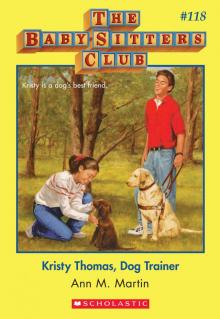 Kristy Thomas, Dog Trainer
Kristy Thomas, Dog Trainer Baby-Sitters' Christmas Chiller
Baby-Sitters' Christmas Chiller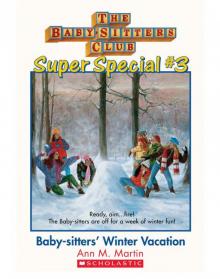 Baby-Sitters' Winter Vacation
Baby-Sitters' Winter Vacation Ten Good and Bad Things About My Life
Ten Good and Bad Things About My Life Claudia and the Bad Joke
Claudia and the Bad Joke Mary Anne's Makeover
Mary Anne's Makeover Stacey and the Fashion Victim
Stacey and the Fashion Victim Dawn Schafer, Undercover Baby-Sitter
Dawn Schafer, Undercover Baby-Sitter Karen's Tuba
Karen's Tuba Dawn's Wicked Stepsister
Dawn's Wicked Stepsister Diary Three: Dawn, Sunny, Maggie, Amalia, and Ducky
Diary Three: Dawn, Sunny, Maggie, Amalia, and Ducky Karen's Nanny
Karen's Nanny Jessi and the Awful Secret
Jessi and the Awful Secret Karen's New Year
Karen's New Year Karen's Candy
Karen's Candy Karen's President
Karen's President Mary Anne and the Great Romance
Mary Anne and the Great Romance Mary Anne + 2 Many Babies
Mary Anne + 2 Many Babies Kristy and the Copycat
Kristy and the Copycat Jessi and the Bad Baby-Sitter
Jessi and the Bad Baby-Sitter Claudia, Queen of the Seventh Grade
Claudia, Queen of the Seventh Grade Claudia and the Lighthouse Ghost
Claudia and the Lighthouse Ghost Karen's New Puppy
Karen's New Puppy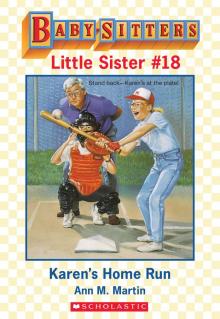 Karen's Home Run
Karen's Home Run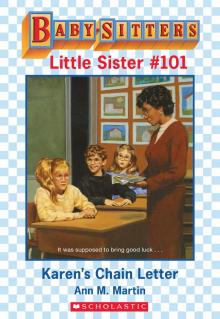 Karen's Chain Letter
Karen's Chain Letter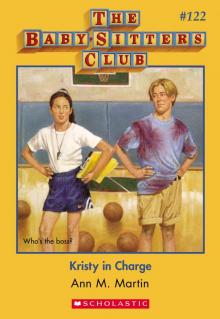 Kristy in Charge
Kristy in Charge Karen's Angel
Karen's Angel Mary Anne and Too Many Boys
Mary Anne and Too Many Boys Karen's Big Fight
Karen's Big Fight Karen's Spy Mystery
Karen's Spy Mystery Stacey's Big Crush
Stacey's Big Crush Karen's School
Karen's School Claudia and the Terrible Truth
Claudia and the Terrible Truth Karen's Cowboy
Karen's Cowboy The Summer Before
The Summer Before Beware, Dawn!
Beware, Dawn! Belle Teale
Belle Teale Claudia's Big Party
Claudia's Big Party The Secret Life of Mary Anne Spier
The Secret Life of Mary Anne Spier Karen's Book
Karen's Book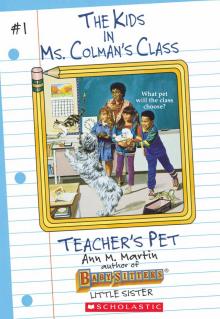 Teacher's Pet
Teacher's Pet Boy-Crazy Stacey
Boy-Crazy Stacey Claudia and the Disaster Date
Claudia and the Disaster Date Author Day
Author Day Claudia and the Sad Good-Bye
Claudia and the Sad Good-Bye Kristy and the Worst Kid Ever
Kristy and the Worst Kid Ever Yours Turly, Shirley
Yours Turly, Shirley Class Play
Class Play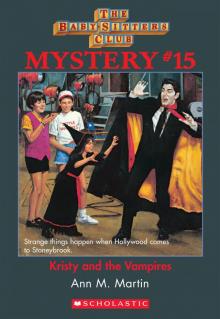 Kristy and the Vampires
Kristy and the Vampires Kristy and the Cat Burglar
Kristy and the Cat Burglar Karen's Pumpkin Patch
Karen's Pumpkin Patch Stacey and the Mystery at the Empty House
Stacey and the Mystery at the Empty House Karen's Chicken Pox
Karen's Chicken Pox Mary Anne and the Playground Fight
Mary Anne and the Playground Fight Stacey's Mistake
Stacey's Mistake Coming Apart
Coming Apart Mary Anne and the Little Princess
Mary Anne and the Little Princess Karen, Hannie and Nancy: The Three Musketeers
Karen, Hannie and Nancy: The Three Musketeers 'Tis the Season
'Tis the Season Claudia and Mean Janine
Claudia and Mean Janine Karen's School Bus
Karen's School Bus Mary Anne's Big Breakup
Mary Anne's Big Breakup Rain Reign
Rain Reign Claudia and the Mystery at the Museum
Claudia and the Mystery at the Museum Claudia and the Great Search
Claudia and the Great Search Karen's Doll
Karen's Doll Shannon's Story
Shannon's Story Sea City, Here We Come!
Sea City, Here We Come! Stacey and the Mystery of Stoneybrook
Stacey and the Mystery of Stoneybrook Karen's Treasure
Karen's Treasure Ten Rules for Living With My Sister
Ten Rules for Living With My Sister With You and Without You
With You and Without You Baby-Sitters' Island Adventure
Baby-Sitters' Island Adventure Karen's Fishing Trip
Karen's Fishing Trip Dawn and the Big Sleepover
Dawn and the Big Sleepover New York, New York!
New York, New York! Ten Kids, No Pets
Ten Kids, No Pets Happy Holidays, Jessi
Happy Holidays, Jessi Halloween Parade
Halloween Parade Karen's New Holiday
Karen's New Holiday Kristy Power!
Kristy Power! Karen's Wish
Karen's Wish Claudia and the Mystery in the Painting
Claudia and the Mystery in the Painting Karen's Stepmother
Karen's Stepmother Abby in Wonderland
Abby in Wonderland Karen's Snow Day
Karen's Snow Day Kristy and the Secret of Susan
Kristy and the Secret of Susan Karen's Pony Camp
Karen's Pony Camp Karen's School Trip
Karen's School Trip Mary Anne to the Rescue
Mary Anne to the Rescue Karen's Unicorn
Karen's Unicorn Abby and the Notorious Neighbor
Abby and the Notorious Neighbor Stacey and the Haunted Masquerade
Stacey and the Haunted Masquerade Claudia Gets Her Guy
Claudia Gets Her Guy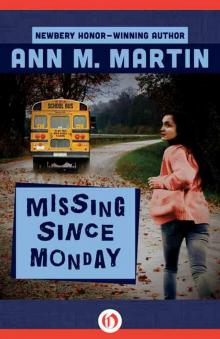 Missing Since Monday
Missing Since Monday Stacey's Choice
Stacey's Choice Stacey's Ex-Best Friend
Stacey's Ex-Best Friend Karen's New Teacher
Karen's New Teacher Karen's Accident
Karen's Accident Karen's Lucky Penny
Karen's Lucky Penny Karen's Cartwheel
Karen's Cartwheel Karen's Puppet Show
Karen's Puppet Show Spelling Bee
Spelling Bee Stacey's Problem
Stacey's Problem Stacey and the Stolen Hearts
Stacey and the Stolen Hearts Karen's Surprise
Karen's Surprise Karen's Worst Day
Karen's Worst Day The Ghost at Dawn's House
The Ghost at Dawn's House Karen's Big Sister
Karen's Big Sister Karen's Easter Parade
Karen's Easter Parade Mary Anne and the Silent Witness
Mary Anne and the Silent Witness Karen's Swim Meet
Karen's Swim Meet Mary Anne's Revenge
Mary Anne's Revenge Karen's Mystery
Karen's Mystery Stacey and the Mystery Money
Stacey and the Mystery Money Dawn and the Disappearing Dogs
Dawn and the Disappearing Dogs Karen's Christmas Tree
Karen's Christmas Tree Welcome to Camden Falls
Welcome to Camden Falls Karen's Pilgrim
Karen's Pilgrim Dawn and the Halloween Mystery
Dawn and the Halloween Mystery Mary Anne in the Middle
Mary Anne in the Middle Karen's Toys
Karen's Toys Kristy's Great Idea
Kristy's Great Idea Claudia and the Middle School Mystery
Claudia and the Middle School Mystery Karen's Big Weekend
Karen's Big Weekend Logan's Story
Logan's Story Karen's Yo-Yo
Karen's Yo-Yo Kristy's Book
Kristy's Book Mallory and the Ghost Cat
Mallory and the Ghost Cat Mary Anne and the Music
Mary Anne and the Music Karen's Tattletale
Karen's Tattletale Karen's County Fair
Karen's County Fair Karen's Mermaid
Karen's Mermaid Snowbound
Snowbound Karen's Movie
Karen's Movie Jessi and the Troublemaker
Jessi and the Troublemaker Baby-Sitters at Shadow Lake
Baby-Sitters at Shadow Lake Mallory on Strike
Mallory on Strike Jessi's Baby-Sitter
Jessi's Baby-Sitter Karen's Leprechaun
Karen's Leprechaun Claudia and the Phantom Phone Calls
Claudia and the Phantom Phone Calls Karen's Good-Bye
Karen's Good-Bye Karen's Figure Eight
Karen's Figure Eight Logan Likes Mary Anne!
Logan Likes Mary Anne! Mary Anne and the Zoo Mystery
Mary Anne and the Zoo Mystery Missy Piggle-Wiggle and the Whatever Cure
Missy Piggle-Wiggle and the Whatever Cure Dawn on the Coast
Dawn on the Coast Stacey and the Cheerleaders
Stacey and the Cheerleaders Claudia and the Clue in the Photograph
Claudia and the Clue in the Photograph Karen's New Friend
Karen's New Friend Mallory and the Trouble With Twins
Mallory and the Trouble With Twins Karen's Roller Skates
Karen's Roller Skates Abby and the Best Kid Ever
Abby and the Best Kid Ever Poor Mallory!
Poor Mallory! Karen's Witch
Karen's Witch Karen's Grandmothers
Karen's Grandmothers Slam Book
Slam Book Karen's School Picture
Karen's School Picture Karen's Reindeer
Karen's Reindeer Kristy's Big Day
Kristy's Big Day The Long Way Home
The Long Way Home Karen's Sleigh Ride
Karen's Sleigh Ride On Christmas Eve
On Christmas Eve Karen's Copycat
Karen's Copycat Karen's Ice Skates
Karen's Ice Skates Claudia and the Little Liar
Claudia and the Little Liar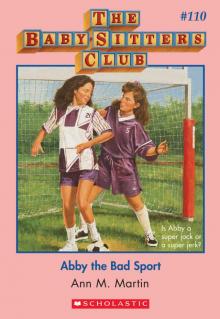 Abby the Bad Sport
Abby the Bad Sport The Baby-Sitters Club #5: Dawn and the Impossible Three
The Baby-Sitters Club #5: Dawn and the Impossible Three Abby's Book
Abby's Book Karen's Big Top
Karen's Big Top Main Street #8: Special Delivery
Main Street #8: Special Delivery Kristy and the Kidnapper
Kristy and the Kidnapper Karen's Ski Trip
Karen's Ski Trip Karen's Hurricane
Karen's Hurricane Stacey and the Mystery at the Mall
Stacey and the Mystery at the Mall Jessi and the Superbrat
Jessi and the Superbrat Kristy and the Baby Parade
Kristy and the Baby Parade Karen's New Bike
Karen's New Bike Karen's Big City Mystery
Karen's Big City Mystery Baby-Sitters' European Vacation
Baby-Sitters' European Vacation Hello, Mallory
Hello, Mallory Dawn's Big Date
Dawn's Big Date Karen's Christmas Carol
Karen's Christmas Carol Jessi's Horrible Prank
Jessi's Horrible Prank Kristy and the Missing Fortune
Kristy and the Missing Fortune Kristy and the Haunted Mansion
Kristy and the Haunted Mansion Jessi's Big Break
Jessi's Big Break Karen's Pony
Karen's Pony Welcome Home, Mary Anne
Welcome Home, Mary Anne Stacey the Math Whiz
Stacey the Math Whiz September Surprises
September Surprises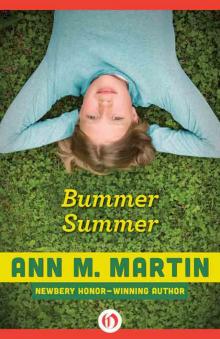 Bummer Summer
Bummer Summer Karen's Secret
Karen's Secret Abby's Twin
Abby's Twin Main Street #4: Best Friends
Main Street #4: Best Friends Karen's Big Move
Karen's Big Move Mary Anne Misses Logan
Mary Anne Misses Logan Stacey's Book
Stacey's Book Claudia and the Perfect Boy
Claudia and the Perfect Boy Holiday Time
Holiday Time Stacey's Broken Heart
Stacey's Broken Heart Karen's Field Day
Karen's Field Day Kristy's Worst Idea
Kristy's Worst Idea Dawn and the Older Boy
Dawn and the Older Boy Karen's Brothers
Karen's Brothers Claudia's Friend
Claudia's Friend Mary Anne and the Haunted Bookstore
Mary Anne and the Haunted Bookstore Dawn and Whitney, Friends Forever
Dawn and Whitney, Friends Forever Summer School
Summer School Karen's Birthday
Karen's Birthday Karen's Black Cat
Karen's Black Cat Stacey McGill... Matchmaker?
Stacey McGill... Matchmaker? Claudia's Book
Claudia's Book Main Street #2: Needle and Thread
Main Street #2: Needle and Thread Karen's Runaway Turkey
Karen's Runaway Turkey Karen's Campout
Karen's Campout Karen's Bunny
Karen's Bunny Claudia and the New Girl
Claudia and the New Girl Karen's Wedding
Karen's Wedding Karen's Promise
Karen's Promise Karen's Snow Princess
Karen's Snow Princess Claudia Kishi, Middle School Dropout
Claudia Kishi, Middle School Dropout Starring the Baby-Sitters Club!
Starring the Baby-Sitters Club! Kristy for President
Kristy for President California Girls!
California Girls! Maid Mary Anne
Maid Mary Anne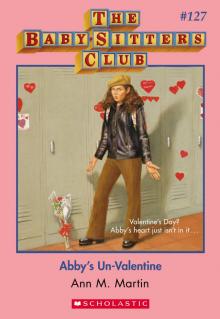 Abby's Un-Valentine
Abby's Un-Valentine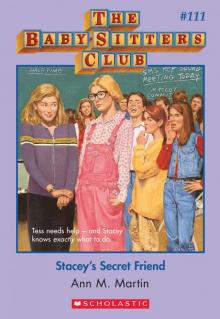 Stacey's Secret Friend
Stacey's Secret Friend Karen's Haunted House
Karen's Haunted House Claudia and Crazy Peaches
Claudia and Crazy Peaches Karen's Prize
Karen's Prize Get Well Soon, Mallory!
Get Well Soon, Mallory! Karen's Doll Hospital
Karen's Doll Hospital Karen's Newspaper
Karen's Newspaper Karen's Toothache
Karen's Toothache Mary Anne and Miss Priss
Mary Anne and Miss Priss Abby's Lucky Thirteen
Abby's Lucky Thirteen The Secret Book Club
The Secret Book Club The All-New Mallory Pike
The All-New Mallory Pike Karen's Turkey Day
Karen's Turkey Day Karen's Magician
Karen's Magician Mary Anne and the Library Mystery
Mary Anne and the Library Mystery Diary One: Dawn, Sunny, Maggie, Amalia, and Ducky
Diary One: Dawn, Sunny, Maggie, Amalia, and Ducky Mary Anne and the Secret in the Attic
Mary Anne and the Secret in the Attic Kristy and the Mother's Day Surprise
Kristy and the Mother's Day Surprise Karen's in Love
Karen's in Love Welcome to the BSC, Abby
Welcome to the BSC, Abby Karen's Kittycat Club
Karen's Kittycat Club The Mystery at Claudia's House
The Mystery at Claudia's House The Truth About Stacey
The Truth About Stacey Karen's Bully
Karen's Bully Karen's Gift
Karen's Gift BSC in the USA
BSC in the USA Everything for a Dog
Everything for a Dog Dawn and the We Love Kids Club
Dawn and the We Love Kids Club Karen's Ghost
Karen's Ghost Stacey's Lie
Stacey's Lie Jessi's Secret Language
Jessi's Secret Language Kristy and the Missing Child
Kristy and the Missing Child Better to Wish
Better to Wish Baby-Sitters on Board!
Baby-Sitters on Board! Kristy at Bat
Kristy at Bat Everything Changes
Everything Changes Don't Give Up, Mallory
Don't Give Up, Mallory A Dog's Life: The Autobiography of a Stray
A Dog's Life: The Autobiography of a Stray Karen's Big Lie
Karen's Big Lie Karen's Show and Share
Karen's Show and Share Mallory Hates Boys (and Gym)
Mallory Hates Boys (and Gym) Diary Two: Dawn, Sunny, Maggie, Amalia, and Ducky
Diary Two: Dawn, Sunny, Maggie, Amalia, and Ducky Karen's Pen Pal
Karen's Pen Pal Claudia and the Friendship Feud
Claudia and the Friendship Feud Karen's Secret Valentine
Karen's Secret Valentine Keep Out, Claudia!
Keep Out, Claudia! Aloha, Baby-Sitters!
Aloha, Baby-Sitters! Welcome Back, Stacey
Welcome Back, Stacey Jessi Ramsey, Pet-Sitter
Jessi Ramsey, Pet-Sitter Karen's Pizza Party
Karen's Pizza Party Kristy and the Dirty Diapers
Kristy and the Dirty Diapers Staying Together
Staying Together Dawn and the Surfer Ghost
Dawn and the Surfer Ghost Claudia Makes Up Her Mind
Claudia Makes Up Her Mind Jessi's Gold Medal
Jessi's Gold Medal Karen's Kite
Karen's Kite Baby Animal Zoo
Baby Animal Zoo Dawn's Big Move
Dawn's Big Move Karen's Big Joke
Karen's Big Joke Karen's Lemonade Stand
Karen's Lemonade Stand Ma and Pa Dracula
Ma and Pa Dracula Baby-Sitters' Haunted House
Baby-Sitters' Haunted House Abby and the Mystery Baby
Abby and the Mystery Baby Home Is the Place
Home Is the Place Karen's Grandad
Karen's Grandad Twin Trouble
Twin Trouble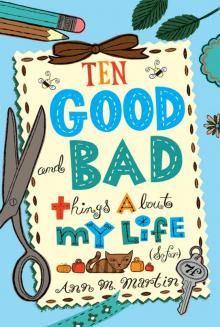 Ten Good and Bad Things About My Life (So Far)
Ten Good and Bad Things About My Life (So Far) Diary Two
Diary Two Baby-Sitters Club 027
Baby-Sitters Club 027 Claudia and the Mystery Painting
Claudia and the Mystery Painting Diary One
Diary One Baby-Sitters Club 037
Baby-Sitters Club 037 Baby-Sitters Club 028
Baby-Sitters Club 028 Baby-Sitters Club 085
Baby-Sitters Club 085 Dawn Schaffer Undercover Baby-Sitter
Dawn Schaffer Undercover Baby-Sitter Jessi's Babysitter
Jessi's Babysitter The Baby-Sitters Club #110: Abby the Bad Sport (Baby-Sitters Club, The)
The Baby-Sitters Club #110: Abby the Bad Sport (Baby-Sitters Club, The) Karen's Little Sister
Karen's Little Sister Baby-Sitters Club 058
Baby-Sitters Club 058 Claudia And The Genius On Elm St.
Claudia And The Genius On Elm St. Missy Piggle-Wiggle and the Sticky-Fingers Cure
Missy Piggle-Wiggle and the Sticky-Fingers Cure Kristy and Kidnapper
Kristy and Kidnapper Baby-Sitters Club 041
Baby-Sitters Club 041 Karen's Bunny Trouble
Karen's Bunny Trouble Baby-Sitters Club 032
Baby-Sitters Club 032 Diary Three
Diary Three Christmas Chiller
Christmas Chiller Karen's Half-Birthday
Karen's Half-Birthday Needle and Thread
Needle and Thread Secret Life of Mary Anne Spier
Secret Life of Mary Anne Spier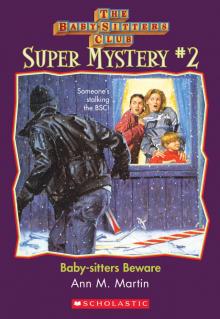 Baby-Sitters Beware
Baby-Sitters Beware Claudia Kishi, Middle School Drop-Out
Claudia Kishi, Middle School Drop-Out Logan Likes Mary Anne !
Logan Likes Mary Anne ! Baby-Sitters Club 061
Baby-Sitters Club 061 Best Friends
Best Friends Baby-Sitters Club 031
Baby-Sitters Club 031 Karen's Little Witch
Karen's Little Witch Jessi Ramsey, Petsitter
Jessi Ramsey, Petsitter Baby-Sitters Club 123
Baby-Sitters Club 123 Baby-Sitters Club 059
Baby-Sitters Club 059 Baby-Sitters Club 033
Baby-Sitters Club 033 Baby-Sitters Club 060
Baby-Sitters Club 060 Baby-Sitters Club 094
Baby-Sitters Club 094 The Baby-Sitters Club #99: Stacey's Broken Heart
The Baby-Sitters Club #99: Stacey's Broken Heart The Baby-Sitters Club #109: Mary Anne to the Rescue (Baby-Sitters Club, The)
The Baby-Sitters Club #109: Mary Anne to the Rescue (Baby-Sitters Club, The) Mystery At Claudia's House
Mystery At Claudia's House Claudia And The Sad Goodbye
Claudia And The Sad Goodbye Mary Anne's Big Break-Up
Mary Anne's Big Break-Up Baby-Sitters Club 025
Baby-Sitters Club 025 Baby-Sitters Club 042
Baby-Sitters Club 042 Stacey and the Mystery of the Empty House
Stacey and the Mystery of the Empty House Karen's Baby-Sitter
Karen's Baby-Sitter Claudia's Friendship Feud
Claudia's Friendship Feud Baby-Sitters Club 090
Baby-Sitters Club 090 Baby-Sitters Club 021
Baby-Sitters Club 021 Baby-Sitters Club 056
Baby-Sitters Club 056 Baby-Sitters Club 040
Baby-Sitters Club 040 The Baby-Sitters Club #108: Don't Give Up, Mallory (Baby-Sitters Club, The)
The Baby-Sitters Club #108: Don't Give Up, Mallory (Baby-Sitters Club, The) Dawn and the Impossible Three
Dawn and the Impossible Three The Snow War
The Snow War Special Delivery
Special Delivery Baby-Sitters Club 057
Baby-Sitters Club 057 Mary Anne And Too Many Babies
Mary Anne And Too Many Babies Baby-Sitters Club 030
Baby-Sitters Club 030